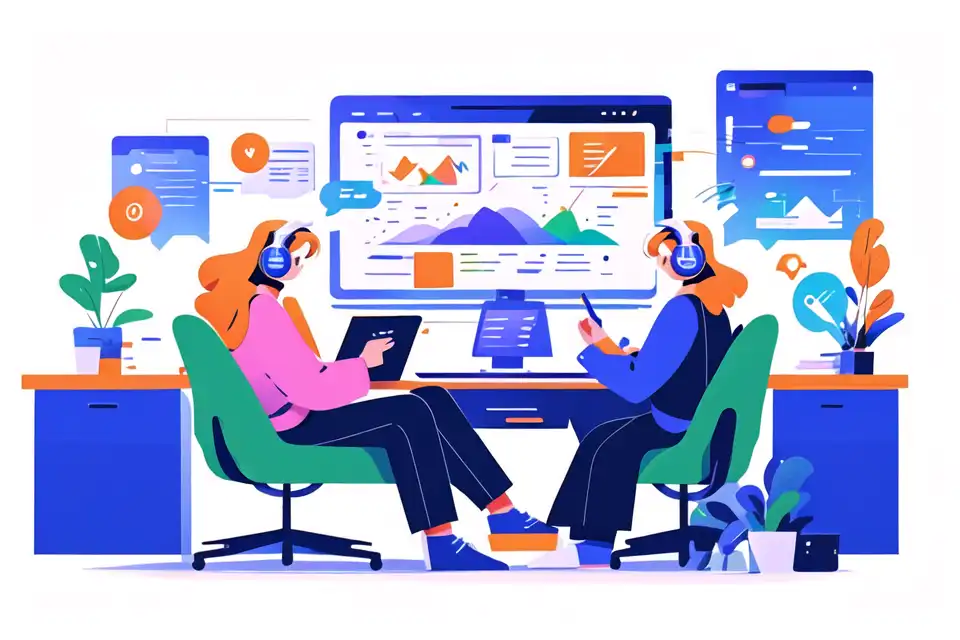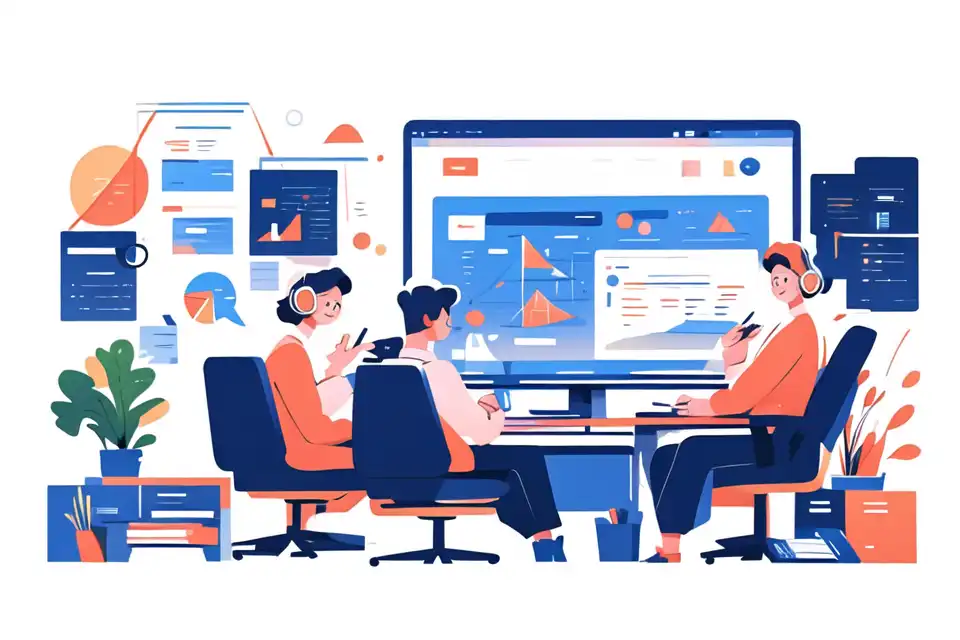Virtual Exchange Programs
Learn about the top tips and strategies in virtual exchange programs
Try Lark for Free
Understanding the Concept of Virtual Exchange Programs
Virtual exchange programs refer to educational initiatives that leverage digital technologies to connect students from different parts of the world. These programs facilitate cross-cultural exchange and collaborative learning, enabling students to gain global perspectives and develop essential 21st-century skills such as communication, critical thinking, and cultural competence. Unlike traditional exchange programs, virtual exchange does not require physical travel, making it more accessible and cost-effective.
The Role of Virtual Exchange Programs in Modern Learning Environments
In today's interconnected world, virtual exchange programs play a crucial role in expanding the boundaries of classrooms. They foster global citizenship, enhance intercultural understanding, and promote digital literacy among students. Moreover, they enable educators to incorporate innovative teaching methods, thereby creating engaging and inclusive learning environments.
Analysis of Current Trends and Statistics in Virtual Exchange Programs
With the growing emphasis on digital education, virtual exchange programs have gained significant momentum in recent years. As per reports, the global virtual exchange market is projected to grow at a CAGR of over 20% during the forecast period 2021-2026. The increasing adoption of these programs is driven by factors such as advancements in technology, increasing globalization, and the need for flexible and personalized learning experiences.
Unlock the power of Lark to elevate your business operations. Discover actionable strategies and best practices in our comprehensive guide.
The numerous benefits of virtual exchange programs
Amplifying Learning Experiences through Virtual Exchange Programs
Virtual exchange programs not only facilitate academic learning but also enrich students' overall learning experiences. They provide exposure to diverse cultures, perspectives, and ideas, fostering empathy, respect, and open-mindedness among students. They also enhance language proficiency and communication skills, thereby preparing students for the global workforce.
Virtual Exchange Programs: A Catalyst for Student Engagement and Outcomes
By integrating technology and collaborative learning, virtual exchange programs can significantly enhance student engagement and learning outcomes. They provide interactive and real-world learning experiences, which foster critical thinking, creativity, and problem-solving skills. Moreover, they facilitate personalized learning, enabling students to learn at their own pace and in their own style, thereby improving academic performance and retention rates.
Learn more about Lark can help you with everything mentioned so far in the article.
How to successfully implement virtual exchange programs in education
Steps to Seamlessly Integrate Virtual Exchange Programs into the Curriculum
Implementing virtual exchange programs involves careful planning and coordination. Key steps include identifying objectives, selecting suitable technology platforms, partnering with foreign institutions, designing engaging activities, and evaluating the program's effectiveness. It is essential to provide adequate training and support to teachers and students to ensure the successful integration of these programs.
Essential Tools and Resources for Effective Virtual Exchange Programs
Effective virtual exchange programs require reliable and user-friendly technology platforms that facilitate communication, collaboration, and content sharing. Tools such as video conferencing, social networking, and project management software can significantly enhance the effectiveness of these programs. Moreover, resources such as digital libraries, online courses, and e-learning materials can enrich students' learning experiences.
Leveraging Lark in Virtual Exchange Programs
Lark, a collaboration suite, is a valuable tool for virtual exchange programs. It offers a wide range of features such as real-time messaging, video conferencing, document collaboration, and calendar management, which facilitate seamless communication and collaboration among students and teachers. Moreover, its robust security features ensure data privacy and protection, making it an ideal choice for educational institutions.
Case studies and real-world examples of virtual exchange programs
Success story 1: transforming classroom dynamics with virtual exchange programs
Success story 1: transforming classroom dynamics with virtual exchange programs
In a school in Singapore, a virtual exchange program was implemented to connect students with their peers in Australia. Through video conferencing and online collaboration, students worked on joint projects, shared their cultures, and gained insights into global issues. The program significantly enhanced students' communication skills, cultural understanding, and global awareness, transforming the classroom dynamics.
Success story 2: the impact of virtual exchange programs on student performance
Success story 2: the impact of virtual exchange programs on student performance
A university in Canada integrated a virtual exchange program into its curriculum to enhance students' language proficiency and intercultural competence. The program involved collaborative projects and peer-to-peer interactions with students in Spain. Post-program evaluations revealed significant improvements in students' Spanish language skills, cultural knowledge, and academic performance.
Success story 3: innovating education through virtual exchange programs with lark
Success story 3: innovating education through virtual exchange programs with lark
A high school in Japan leveraged Lark for its virtual exchange program with a school in the US. Through Lark's messaging and video conferencing features, students engaged in cross-cultural discussions, presentations, and group projects. The program fostered global citizenship, digital literacy, and collaborative learning among students, demonstrating the potential of Lark in innovating education.
Learn more about Lark can help you with everything mentioned so far in the article.
Addressing challenges and crafting solutions in virtual exchange programs
Identifying Potential Hurdles in Virtual Exchange Programs
Implementing virtual exchange programs can pose several challenges such as technical issues, time zone differences, language barriers, and lack of digital literacy. Moreover, engaging students in virtual interactions and managing cross-cultural misunderstandings can be challenging.
Developing Strategies to Overcome Challenges in Virtual Exchange Programs
Overcoming these challenges requires strategic planning and effective solutions. This involves investing in reliable technology infrastructure, providing technical support, scheduling flexible timings, offering language assistance, and conducting digital literacy training. Moreover, fostering a culture of respect and open communication can help manage cultural differences and enhance collaboration.
Gazing into the future of virtual exchange programs in education
Upcoming Trends in Virtual Exchange Programs
Virtual exchange programs are set to evolve with advancements in technology and changing educational needs. Emerging trends include gamification, virtual reality, and AI-powered learning, which can further enhance the effectiveness and engagement of these programs. Moreover, the integration of virtual exchange with online learning platforms and MOOCs is expected to offer new learning opportunities.
Future Predictions: The Influence of Virtual Exchange Programs on Education
In the future, virtual exchange programs are likely to become an integral part of education, influencing teaching methodologies, curriculum design, and learning experiences. They are expected to foster a global learning community, democratize education, and prepare students for the digital and globalized world. Moreover, they may catalyze the shift towards digital and lifelong learning, shaping the future of education.
Learn more about Lark can help you with everything mentioned so far in the article.
Conclusion
Recapitulation: The Unquestionable Significance of Virtual Exchange Programs
In conclusion, virtual exchange programs are transforming education, offering unprecedented learning opportunities for students and educators alike. Despite the challenges, their numerous benefits and growing relevance in the digital era make them an indispensable part of modern education. As they continue to evolve, they hold immense potential to innovate education and shape a better future for learners worldwide.
Learn more about Lark can help you with everything mentioned so far in the article.
A step-by-step guide to implementing virtual exchange programs
- Identify your objectives and learning outcomes for the program.
- Select suitable technology platforms for communication and collaboration.
- Partner with foreign institutions for the exchange.
- Design engaging activities and projects for cross-cultural learning.
- Provide training and support to teachers and students.
- Implement the program and monitor its progress.
- Evaluate the program's effectiveness and make necessary adjustments.
Do's and don'ts of implementing virtual exchange programs
| Do's | Don'ts |
|---|---|
| 1. Do ensure you have the necessary tools and resources | 1. Don't rush the implementation process |
| 2. Do engage in thorough planning before integrating the program into the curriculum | 2. Don't ignore the potential challenges |
| 3. Do ensure consistent monitoring and evaluation of the program's effectiveness | 3. Don't overlook the importance of student feedback |
Unlock the power of Lark to elevate your business operations. Discover actionable strategies and best practices in our comprehensive guide.








